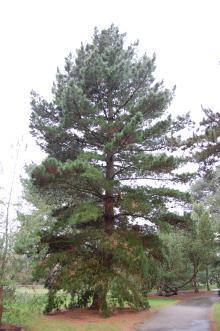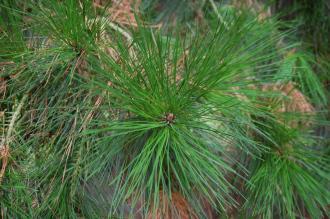
Pinus radiata (09/02/2013, Kew Gardens, London)
Position: Full sun
Flowering period: Early spring
Soil: Moist, well drained
Eventual Height: 30m
Eventual Spread: 20m
Hardiness: 8a – 10a
Family: Pinaceae
Pinus radiata is a fast growing evergreen coniferous tree with a broad rounded crown. Its bright green leaves are in the form of needles, appear in groups of three, up to 15cm long and has a blunt tip. Its trunk may achieve a diameter of up to 90cm. Its grey/ red/ brown bark is fissured and deeply furrowed. Its monoecious flowers are in the form of ellipsoid pollen cones and are up to 15mm long, the male are orange/ brown, the female purple. Its fruit are brown cones, are up to 17cm long when mature.

Pinus radiata Leaf (09/02/2013, Kew Gardens, London)
Pinus radiata, commonly known as Monterey Pine, Insignis Pine or Radiata Pine, is native to coastal regions of California. In its native habitat this tree is classified as Least Concern according to the IUCN Red List of Threatened Species. Despite this, this tree is the most widely planted Pine in the world.
The etymological root of the binomial name Pinus is the old classical name for ‘Pine tree’. Radiata is derived from the Latin radiatus meaning ‘rayed’.
The landscape architect may find Pinus radiata useful as a coniferous tree for coastal maritime locations. Once established this tree is drought tolerant.
Ecologically, Pinus radiata the seeds of this tree are attractive to some birds.
Pinus radiata Bark (09/02/2013, Kew Gardens, London)
The Royal Horticultural Society has given Pinus radiata their prestigious Award of Garden Merit in 1993.
Pinus radiata prefers moist, well-drained soils. It tolerates most pH of soil. It dislikes wet soils.
Pinus radiata requires little maintenance.


